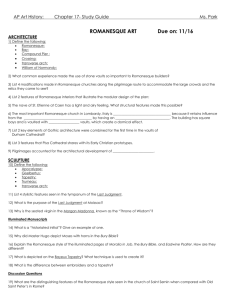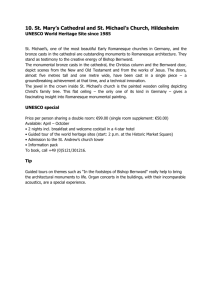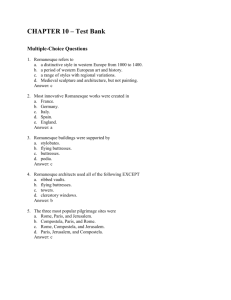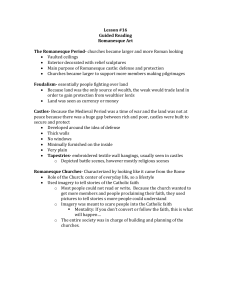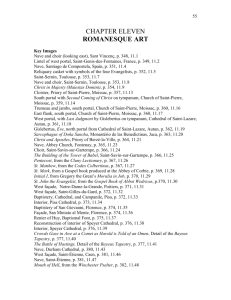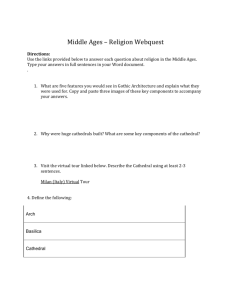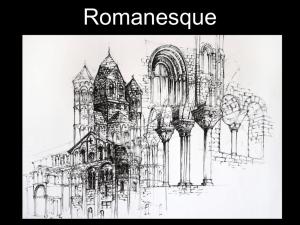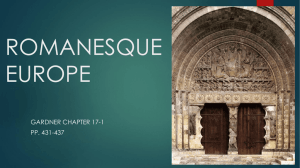Chapter 12 Questions
advertisement
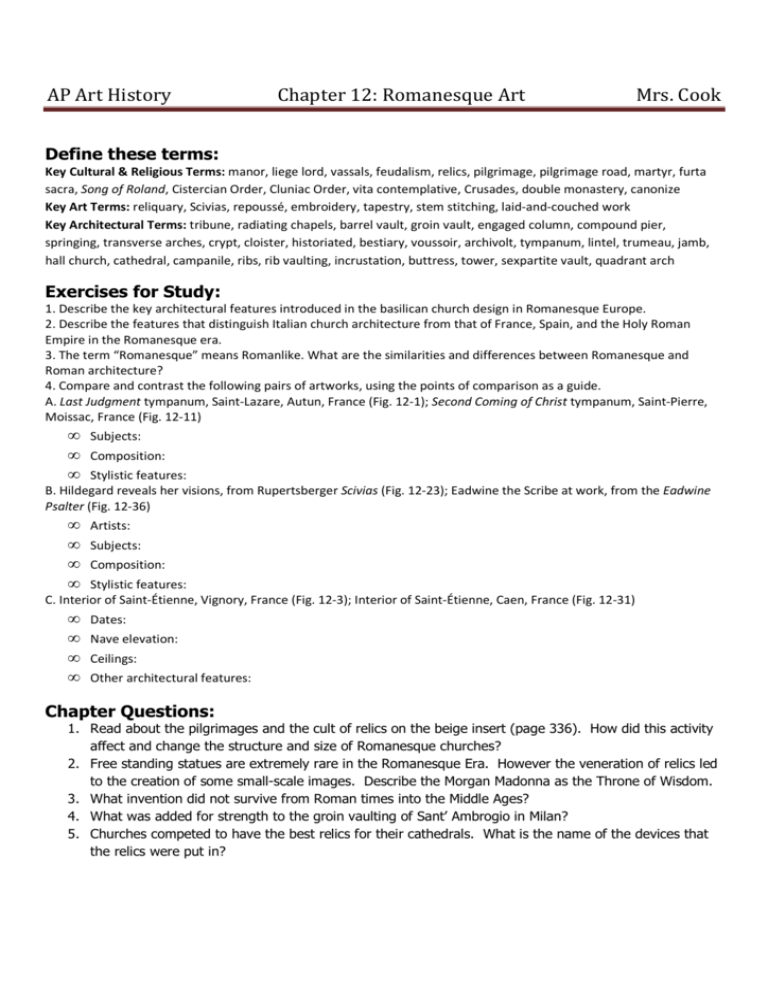
AP Art History Chapter 12: Romanesque Art Mrs. Cook Define these terms: Key Cultural & Religious Terms: manor, liege lord, vassals, feudalism, relics, pilgrimage, pilgrimage road, martyr, furta sacra, Song of Roland, Cistercian Order, Cluniac Order, vita contemplative, Crusades, double monastery, canonize Key Art Terms: reliquary, Scivias, repoussé, embroidery, tapestry, stem stitching, laid-and-couched work Key Architectural Terms: tribune, radiating chapels, barrel vault, groin vault, engaged column, compound pier, springing, transverse arches, crypt, cloister, historiated, bestiary, voussoir, archivolt, tympanum, lintel, trumeau, jamb, hall church, cathedral, campanile, ribs, rib vaulting, incrustation, buttress, tower, sexpartite vault, quadrant arch Exercises for Study: 1. Describe the key architectural features introduced in the basilican church design in Romanesque Europe. 2. Describe the features that distinguish Italian church architecture from that of France, Spain, and the Holy Roman Empire in the Romanesque era. 3. The term “Romanesque” means Romanlike. What are the similarities and differences between Romanesque and Roman architecture? 4. Compare and contrast the following pairs of artworks, using the points of comparison as a guide. A. Last Judgment tympanum, Saint-Lazare, Autun, France (Fig. 12-1); Second Coming of Christ tympanum, Saint-Pierre, Moissac, France (Fig. 12-11) • • • Subjects: • • • • Artists: • • • • Dates: Composition: Stylistic features: B. Hildegard reveals her visions, from Rupertsberger Scivias (Fig. 12-23); Eadwine the Scribe at work, from the Eadwine Psalter (Fig. 12-36) Subjects: Composition: Stylistic features: C. Interior of Saint-Étienne, Vignory, France (Fig. 12-3); Interior of Saint-Étienne, Caen, France (Fig. 12-31) Nave elevation: Ceilings: Other architectural features: Chapter Questions: 1. Read about the pilgrimages and the cult of relics on the beige insert (page 336). How did this activity affect and change the structure and size of Romanesque churches? 2. Free standing statues are extremely rare in the Romanesque Era. However the veneration of relics led to the creation of some small-scale images. Describe the Morgan Madonna as the Throne of Wisdom. 3. What invention did not survive from Roman times into the Middle Ages? 4. What was added for strength to the groin vaulting of Sant’ Ambrogio in Milan? 5. Churches competed to have the best relics for their cathedrals. What is the name of the devices that the relics were put in? AP Art History Chapter 12: Romanesque Art Mrs. Cook 6. At Pisa, 2 major parts of the cathedral are separate buildings. What are they? Some buildings at Pisa as well as San Giovanni in Florence have beautiful panels of wall decoration in different colors of marble. This is called __________. 7. The Florence Baptistery shows a heritage and influence from many different buildings we have studied. List 3. 8. How does Durham’s cathedral in England differ from the Speyer & Saint-Etienne? 9. The Bayeux Tapestry is not a tapestry, but actually a __________. How long is this medieval narrative? It makes sense, that it probably was displayed in the church’s ________ where is gets its name. Who probably made it? What significant event in Norman/English history does this tapestry depict? 10. When and where do English coronations take place, even to this day?
